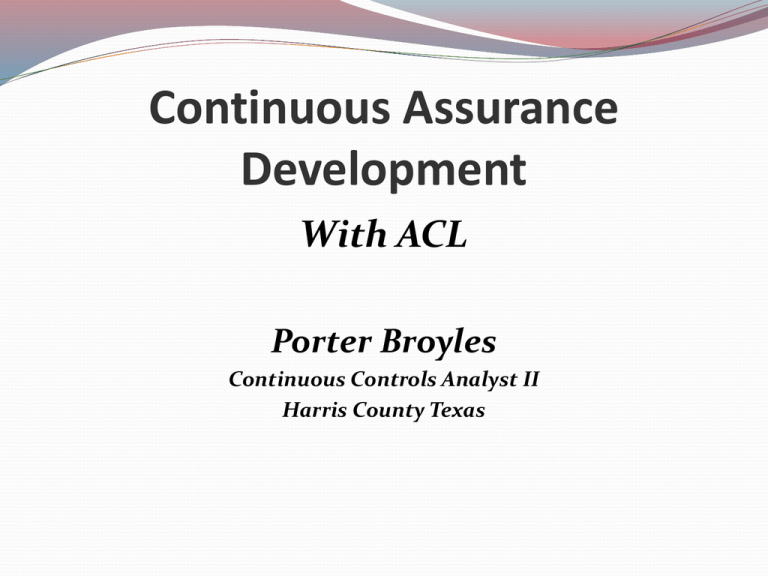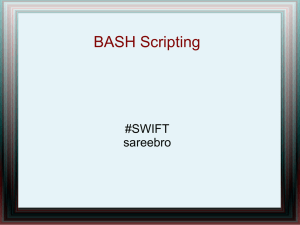Introduction to Modular Script Writing
advertisement

Continuous Assurance
Development
With ACL
Porter Broyles
Continuous Controls Analyst II
Harris County Texas
Goals and Objectives
To demonstrate versatile power of ACL.
To provide HINTS as to how to tap this power.
To provide some best practices.
To cover a simple model of project development.
To present some advanced concepts of "next steps."
Harris County Auditor’s Office Projects
Auditor’s office projects may have:
90+ individual scripts,
300+ pages of scripting,
100’s of individual tests,
Perform millions of comparisons.
How do we do it?
Standards and Procedures
Want to write projects that
Are easily expandable.
Are easily editable
Others can review and understand
Are modular in design
Do not pose a risk to currently approved projects
That minimize the number of reports generated
Pet Peeve
About
With that being said,
Presentations
Let’s have a
demonstration
Modular Scripting
Modular script writing is the use of standardized
scripts to perform repeated processes over and
over the exact same way without having to
reinvent the wheel every time we write a new
script.
Repeated processes
Modules can be made out of:
Load Processes
Processes asking for user input
Standardized tests
Repeatable tests
Standardizing reports
Normalization of data
Clean up of the project
Example: The Load Process
Key to getting Modules to work
Tables need to be loaded same way every time.
Same field names.
Variables need to be defined consistently.
Same data characteristics.
Field size/type etc
Still an issue even with 9.2+.
Methodology needs to be consistent.
Loading isn’t just loading
It’s testing to ensure that the data is as expected:
Did new data exist to be loaded?
Was the data Verified?
Did duplicate data exist in key fields?
How many records were loaded?
If the data was delimited, were there records with too
many/few delimiters?
How do these results compare to the last time the data
was loaded?
In other words: how can we ensure that the data was
loaded correctly when we might not be there to view it?
Skeleton Load Process
Load Process
CA01Master Script
Script controls load process
This script is only called when a project/table requires special treatement
3
1
2
BC01_Select_Table
Process to pick tables
used in project
CA30 Verify Fields
Control Script
accumulating results from
load
CA02 Load Data Loop
Series of Script to Load data files
Process repeated
Until options selected
1
3x
BE01 Error Extracxt
2
1
3
2 - Repeated for each
table being loaded
CA03_Select DatesGLT
Defines v_new_dateGLT
BC02 Table Select
User selects tables
1 - Process repeated
to create dialog bod
ca40_dATAnORMALIZATI
ON_%v_type%
Script normalizes data
fields. Currenly only used
in IA01---which is a
project that hasn’t been
worked much.
CA31 Bars Err
Identify Bar differences
CA32 Load Err
Load Errors
CA33 Verify ERR
Identify invalid fields
BE01 Error Extracxt
BE01 Error Extracxt
BE01 Error Extracxt
2 - Repeat to
create list
BC03_Define_Diabx
Creating Dialog Box
CA06_Load_SQL_IMP
Import Files selected in BC01
BC04 Create List
Creating list of items
7
6
5 --- If table is GLTTRNSDT
4
1
2
CA36 Date_ERR
Checks to see if create date
of folder is the same as data
date
CA21 BarDelimi Clnup
Checks to see if table has
extra bars that needs to be
cleaned up
BE01 Error Extracxt
Process is repeated if there are
records with extra bar delimiters
CA22 BarDelimit2 CLNUP2
3
CA07_Loaddetail
Identifies syntax for
loading each table
CA23 Format STB
Takes care of issue with the
SYSTRANSBODY table
BE02_NoLoad_Extract
Extracts record if no
tables are loaded
CA08_Communal
Cumulative file for
GLTTRNSDT
KEY
CA34 Field Err
CA35 record Err
BE01 Error Extracxt
BE01 Error Extracxt
Yellow boxes indicate shared scrpts
Green boxes indicate processes that are
repeated via a DO WHILE Sequence
It’s
not
Ok Maybe
cary
a little
that s
How to achieve this
Naming Conventions
Script Names
Variables
Bat Files
Limited Intelligent Scripts
User Inquiry
Dual Purpose Scripting
Project Names
We use alpha-numeric combinations:
2-3 letters to describe the nature of the project
AP --- Accounts Payable
AR --- Account Receivable
GL --- General Ledger
GLT --- General Ledger Transactions
ACS --- Account Code Structure
2 numbers o1 -99
Script Names
AX## = Start up scripts
BX## = repeating scripts within the project
CX## = Data Load Scripts
DX## = ChAD Scripts
EX## -WX## = Processing/Analytic Scripts
Usually 1 or 2 alpha prefixes per project
YX## = Administrative Functions
ZX## = Shut down/Clean Up Scripts
nd
2
and
rd
3
Parts
With both scripts and projects, I will have a second part
and possibly 3rd part that describes what the script does.
The second part is usually what the script/project does
and the third part may describe or qualify the second.
But when referring to the project or script, I always do so
via the alpha-numeric constructs.
Alpha-numerics = outline
By using an alpha-numeric combination, we create an
outline of the project.
AA01 should occur before AA02
AA02 should occur before AA03
AA## should occur before BA##
And so forth.
Standardized Variables
Variables usually have 3 components.
1) v_ as the prefix to define it as a variable.
2) a description of the variable
3) a qualifier of the description
V_TYPE = the alpha-numeric for the project
v_Path_{qualifier} = path on hard drive
V_date_{qualifier} = a date value of some sort
V_COUNT_{qualifier} = a count of something
V_flag_{qualifier} = a flag for an error trap/do while sequence
Interesting dilemma
You are writing a sub process in a project. There are 5
scripts in the sub process. The process is intended to be
a generic process usable with multiple projects. The
catch is that the fourth script in the project has to be a
little different based upon the criteria of the individual
project.
Traditional approach:
GL01
ACS01
AP01
XX01
copy
XX01
copy
XX01
XX02
copy
XX02
copy
XX02
XX03
copy
XX03
copy
XX03
XX04
XX05
XX04
copy
XX05
XX04
copy
XX05
In other words:
XX01
XX01
XX01
XX02
XX02
XX02
XX03
XX03
XX03
XX04
XX04_GL01
XX04
XX04_ACS01
XX04_%v_type%
XX05
XX05
XX05
What
This
You
is
so
don’t
think
it’s
Cool
cool?
XX04
XX04_AP01
Similar example:
Same concept can be used elsewhere:
48 tables use same process, but 2 tables require specialized
processing:
IF NOT MATCH("%v_table%", "HR_table, AP_table") DO AB01_dataload
IF MATCH("%v_table%", "HR_table, AP_table") DO AB01_dataload_%v_table%
Bat File Basics
We write all of our scripts and save them as .bat files
outside of ACL.
The scripts will be saved in specific folders. Some
folders are generic for all shared scripts, other folders
will be project specific.
These paths are then defined in the project start up
scripts.
Bat Paths
ACS01 Account Code Structure
V_type = "ASC01"
V_path_gen = "X:\CONAUD\Shared_scripts\"
V_path_spec ="X:\CONAUD\ACS01\"
GLT01 General Ledger Testing
V_type = "GLT01"
V_path_gen = "X:\CONAUD\Shared_scripts\"
V_path_spec ="X:\CONAUD\GLT01\"
AP01 Accounts Payable
V_type = "AP01"
V_path_gen = "X:\CONAUD\Shared_scripts\"
V_path_spec ="X:\CONAUD\AP01\"
Notice the standardization:
ACS01 Account Code Structure
V_type = "ASC01"
V_path_spec ="X:\CONAUD\ACS01\"
GT01 General Ledger Transaction Testing
V_type = "GT01"
V_path_spec ="X:\CONAUD\GT01\"
SA01 Security Analysis
V_type = "SA01"
V_path_spec ="X:\CONAUD\SA01\"
OR
V_path_spec ="X:\CONAUD\%v_type%\"
Using a bat file
DO "%v_path_spec%XX04_%v_type%.bat"
DELETE SCRIPT XX04_%v_type% OK
Calling scripts
If calling a generic script:
DO SCRIPT "%v_path_gen%XX01_Loadstart.bat"
If calling a project specific script:
DO SCRIPT "%v_path_spec%XX02_tablelist_%v_type%.bat"
Limited Intelligence (LI)
Limited Intelligent Scripts are scripts that use known
information to infer what the user would want:
Query the hard drive to determine what the most recent
date we have for data.
To identify the most recent two dates we have loaded in
ACL to use those dates in an analysis.
To analyze data and rank potential risks
(vendors/employees with most transaction, highest
dollar amount, most errors, etc.)
To identify tables based upon pre-selected criteria.
To calculate dates/ranges/amounts based upon data.
Limited Intelligence example:
Suppose the analysis is looking to start on the previous
Sunday and end on the previous Saturday. Rather than
hardcoding those dates or asking the user to enter them,
we can have ACL calculate the dates in question:
v_date_start =CTOD(DATE(),"MM/DD/YYYY")-DOW(CTOD(DATE(),"MM/DD/YYYY")) -6
V_date_end = CTOD(DATE(),"MM/DD/YYYY")-DOW(CTOD(DATE(),"MM/DD/YYYY"))
Interactive – LI Scripting
Interactive-Limited Intelligence scripting is the use of
asking for user input while providing a default option
based upon predetermined assumptions.
If a script is coded to always use the variables
determined by ACL, then the script is useless under
anything but ideal situations.
Interactive – LI Scripting example
v_date_start =CTOD(DATE(),"MM/DD/YYYY")DOW(CTOD(DATE(),"MM/DD/YYYY")) -6
V_date_end = CTOD(DATE(),"MM/DD/YYYY")DOW(CTOD(DATE(),"MM/DD/YYYY"))
V_amt = 5000
DIALOG (DIALOG TITLE "User Dialog" WIDTH 401 HEIGHT 233 )
(BUTTONSET TITLE "&OK;&Cancel" AT 300 24 DEFAULT 1 ) (TEXT
TITLE "Enter Start Date" AT 24 64 WIDTH 87 ) (EDIT TO "v_date_start"
AT 132 60 DEFAULT "%v_date_start%" ) (TEXT TITLE "Enter End Date"
AT 24 100 ) (EDIT TO "v_date_end" AT 132 96 DEFAULT "%v_date_end%"
) (TEXT TITLE "Enter Amount" AT 24 136 ) (EDIT TO "v_amt" AT 132 132
DEFAULT "%v_amt%" )
Variable Substitution/GUI Bug
Warning, using percentage signs around a variable is known
as Macro Substitution. It tells ACL to read the variable as the
value stored in the variable and not the variable itself.
If you use a GUI tool to edit a command that includes Macro
Substitution when after the variable is defined, then ACL will
not save the variable when you leave the GUI, but will hard
code the value of the variable into the command!
BEST PRACTICE:
ALWAYS DELETE VARIABLES BEFORE GUI EDITING!
Dual Purpose Dilemma
Write one script that can be
used both manually and in an
automated mode!
Two start-up scripts
Two start off scripts:
AA00_Start_manual
V_conmon = F
V_type = “AP01”
DO AA01_start_%v_type%
AA00_Start_Auto
V_conmon = T
V_type = “AP01”
DO AA01_start_%v_type%
V_conmon turns on/off dialog boxes
v_date_start =CTOD(DATE(),"MM/DD/YYYY")DOW(CTOD(DATE(),"MM/DD/YYYY")) -6
V_date_end = CTOD(DATE(),"MM/DD/YYYY")DOW(CTOD(DATE(),"MM/DD/YYYY"))
V_amt = {calculated average of the amount field + 1 standard deviation}
IF v_CONMON = T
F DIALOG (DIALOG TITLE "User Dialog" WIDTH 401
HEIGHT 233 ) (BUTTONSET TITLE "&OK;&Cancel" AT 300 24 DEFAULT 1 )
1(TEXT
) (TEXT
TITLE
"Enter
Start
Date"
WIDTH
) (EDIT
TITLE
"Enter
Start
Date"
ATAT
24 24
64 64
WIDTH
87 87
) (EDIT
TOTO
"v_date_start"
"v_date_start"
AT 132"%v_date_start%"
60 DEFAULT "%v_date_start%"
(TEXTEnd
TITLE
AT 132 60 DEFAULT
) (TEXT TITLE)"Enter
Date" AT 24
"Enter
End Date"
AT 24 100 ) (EDIT
"v_date_end"
AT 132 96
100 ) (EDIT
TO "v_date_end"
AT 132TO
96 DEFAULT
"%v_date_end%"
) (TEXT
DEFAULT
"%v_date_end%"
TITLE
Amount"
136 )
TITLE "Enter
Amount" AT 24) (TEXT
136 ) (EDIT
TO"Enter
"v_amt"
AT 132AT
13224
DEFAULT
(EDIT
TO "v_amt"
AT 132 132 DEFAULT "%v_amt%" )
"%v_amt%"
)
Shared Script Example:
Exception reports
Most people when they write a test, they generate a
separate report for each test. In other words, if they
perform 100 tests, they will have 100 different reports.
This becomes cumbersome and impractical for larger
Continuous Assurance programs. Who wants to review
100 different reports on a daily basis?
Error Report Process
We generate 1 report that captures all of the information
from every test performed. Basically, the process is:
Create an exception report as normal
Identify key elements needed to identify
record/exception.
ASSIGN those elements to variables.
Execute BE01_ERROR_Report
BE01_Error_report extracts values to standard report
Example: Spending Limit
User
Amount Trans_date PO Number Invoice Number
Jordan 5200
7/26/2012 PDB-12345
H9999
Dave
6500
7/15/2012 K-1243
H9231
V_test = "’Spending Limit’"
V_key_fields = "’PO_Number + Invoice_Number’"
V_key_data = ALL(PO_Number) + ALL(Invoice_number)
(Assign other values to variables)
DO "%V_PATH_GEN%BE01_error_report.BAT"
BE01_error_report
The Error Report script is simply a report
EXTRACT FIELDS SUB(%v_key_fields%,1,30) as "Key Fields"
SUB(%v_key_data%,1,30) as "Key Data" {Other fields as values} TO
TEMP101 APPEND
BEST PRACTICE: After calling the script redefine or delete the variables
so that they are not mistakenly used with another test.
Example: Approver terminated
User
John
Sue
Amount date
300
6/15/2012
560
6/6/2012
PO Number
K-0999
SK-123
Invoice Number
H7892
H8564
V_test = "’Approver Terminated’"
V_key_fields = "’PO_Number + Invoice_Number’"
V_key_data = ALL(PO_Number) + ALL(Invoice_number)
(Assign other values to variables)
DO "%V_PATH_GEN%BE01_error_report.BAT"
Term_date
4/30/2012
3/12/2010
BE01_error_report
The Error Report script is simply a report
EXTRACT FIELDS SUB(%v_key_fields%,1,30) as "Key Fields"
SUB(%v_key_data%,1,30) as "Key Data" {Other fields as values} TO
TEMP101 APPEND
BEST PRACTICE: After calling the script redefine or delete the variables
so that they are not mistakenly used with another test.
Exception Report result
Data
Test Desc Type Date
field_1
field_2
field_3
Key_data
key_fields
Approver
Termed GT01 8/1/2012 John
PO_Number +
4/30/2012 6/15/2012 K-0999 + H7892 Invoice_number
Approver
Termed GT01 8/1/2012 Sue
Spending
Limit
Analysis GT01 8/1/2012 Jordan
Spending
Limit
Analysis GT01 8/1/2012 Dave
PO_Number +
3/12/2010 6/6/2012 SK-123 + H8564 Invoice_number
5200
pdb-1234 +
7/26/2012 H9999
PO_Number +
Invoice_number
6500
PO_Number +
7/15/2012 K-1243 + H9231 Invoice_number
Naming of Reports
Guess what… when extracting/exporting the reports,
there is a piece of information that should be included
in the title…
Report_%v_type%_{description of report}_%v_date_run%
Questions?
Porter Broyles
Porter@SomeClownConsulting.com
www.texasacl.com







